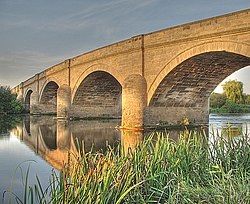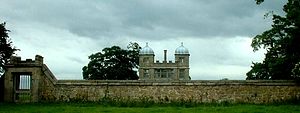Difference between revisions of "Swarkestone"
(Created page with "{{Infobox town |name=Swarkestone |county=Derbyshire |picture=Swarkestone Bridge.jpg |picture caption=Swarkestone Bridge |os grid ref=SK372286 |latitude=52.853 |longitude=-1.45...") |
|||
| (One intermediate revision by one other user not shown) | |||
| Line 18: | Line 18: | ||
Swarkestone has a very old village church, a full cricket pitch, the ''Crewe and Harpur'' pub, a canal with locks, moorings and canalside tea-rooms. It was mentioned twice in the [[Domesday Book]] as ''Sorchestun'' or ''Suerchestune'', and it is recorded as being worth twenty shillings.<ref name="Domesday">''Domesday Book: A Complete Translation''. London: Penguin, 2003. ISBN 0-14-143994-7 p.742 & 749</ref> | Swarkestone has a very old village church, a full cricket pitch, the ''Crewe and Harpur'' pub, a canal with locks, moorings and canalside tea-rooms. It was mentioned twice in the [[Domesday Book]] as ''Sorchestun'' or ''Suerchestune'', and it is recorded as being worth twenty shillings.<ref name="Domesday">''Domesday Book: A Complete Translation''. London: Penguin, 2003. ISBN 0-14-143994-7 p.742 & 749</ref> | ||
| − | == | + | ==Swarkestone Bridge== |
| − | The ancient bridge at Swarkestone crosses the [[River Trent]] about | + | {{Main|Swarkestone Bridge}} |
| + | The ancient bridge at Swarkestone crosses the [[River Trent]] about six miles south of [[Derby]] and was for about 300 years the [[Midlands]]' main crossing of the Trent, since it was the only crossing between [[Burton upon Trent]] and [[Nottingham]],<ref name=autogenerated1>{{cite book|last=Wadd|first=Barbara|title=More Ghost Walks in Derbyshire|year=2007|publisher=Cromwell Press|location=Wiltshire|isbn=978-1-85983-556-2}}</ref> The bridge is a Grade-I-listed structure and a Scheduled Ancient Monument. | ||
| − | + | Swarkestone bridge was built in the 13th century to cross the river and its surrounding marshes, between the villages of Swarkestone and [[Stanton by Bridge]].<ref name=engbridge>[http://list.english-heritage.org.uk/resultsingle.aspx?uid=1088337 Swarkestone Bridge and Causeway], English Heritage, retrieved 7 September 2014</ref> It was financed by the two '''Bellamont'' sisters. Both had become engaged and were to throw a joint celebration; their fiancés, however, had to meet the local barons on the far side of the river.<ref name=autogenerated1 /> Following a storm the Trent became swollen; eager to return to their brides-to-be and their party, the men tried to ford the river on horseback: both were swept away and drowned.<ref name=autogenerated1 /> The Bellamont sisters commissioned the bridge so that no one else would suffer the tragedy they had.<ref name=autogenerated1 /> Neither sister married and both died in poverty having exhausted their fortune on building the bridge.<ref name=autogenerated1 /> | |
| − | Swarkestone bridge was built in the 13th century to cross the river and its surrounding marshes, between the villages of | + | |
| − | + | ||
| − | + | ||
| − | + | ||
| − | + | ||
| − | + | ||
| − | + | ||
| − | + | ||
| − | + | ||
| − | + | ||
| − | + | ||
| − | + | ||
| − | + | ||
| − | + | ||
| − | + | ||
| − | + | ||
==History== | ==History== | ||
Latest revision as of 08:16, 10 July 2018
| Swarkestone | |
| Derbyshire | |
|---|---|
 Swarkestone Bridge | |
| Location | |
| Grid reference: | SK372286 |
| Location: | 52°51’11"N, 1°27’4"W |
| Data | |
| Post town: | Derby |
| Postcode: | DE73 |
| Dialling code: | 01332 |
| Local Government | |
| Council: | South Derbyshire |
| Parliamentary constituency: |
South Derbyshire |
Swarkestone is a village in Derbyshire, on the River Trent south of the county town, Derby.
Swarkestone has a very old village church, a full cricket pitch, the Crewe and Harpur pub, a canal with locks, moorings and canalside tea-rooms. It was mentioned twice in the Domesday Book as Sorchestun or Suerchestune, and it is recorded as being worth twenty shillings.[1]
Contents
Swarkestone Bridge
- Main article: Swarkestone Bridge
The ancient bridge at Swarkestone crosses the River Trent about six miles south of Derby and was for about 300 years the Midlands' main crossing of the Trent, since it was the only crossing between Burton upon Trent and Nottingham,[2] The bridge is a Grade-I-listed structure and a Scheduled Ancient Monument.
Swarkestone bridge was built in the 13th century to cross the river and its surrounding marshes, between the villages of Swarkestone and Stanton by Bridge.[3] It was financed by the two 'Bellamont sisters. Both had become engaged and were to throw a joint celebration; their fiancés, however, had to meet the local barons on the far side of the river.[2] Following a storm the Trent became swollen; eager to return to their brides-to-be and their party, the men tried to ford the river on horseback: both were swept away and drowned.[2] The Bellamont sisters commissioned the bridge so that no one else would suffer the tragedy they had.[2] Neither sister married and both died in poverty having exhausted their fortune on building the bridge.[2]
History
Evidence of the Beaker people living near Swarkestone was discovered in the 1950s. At that time it was estimated that people had lived near Swarkestone for at least 3,800 years.[4] The only surviving Bronze Age barrow cemetery in the Trent valley is at Swarkestone Lows near the A50. The barrow is a registered national monument.[5]
In the Domesday Book, Swarkestone was held by the King and by Henry de Ferrers.[1]
In the Battle of Swarkestone Bridge during the Civil War (1643), the village was defended by the Royalists against the Parliamentarians, but the outnumbered Cavaliers lost the day.
In 1745 during the Jacobite Rebellion led by 'Bonnie Prince Charlie', the advance party of his army reached here to gain control of the crossing of the Trent. Finding no reports of support from the south, they turned back to Derby; the invading army then retreated to the Highlands and final defeat at the Battle of Culloden. Swarkestone was thereby the most southerly point reached during that army's advance on London.
Sport
- Cricket: Swarkestone Cricket Club
The Pavilion
Nearby is the Jacobean grandstand called Swarkestone Hall Pavilion and walled area, formerly connected with Harpur Hall, where (it is believed, reported by Pevsner), bull-baiting took place. The pavilion is attributed to John Smythson who also designed Bolsover Castle, and is Grade I Listed.[6] It was repaired and is now owned by the Landmark Trust who maintain it and rent it out to holidaymakers.
Pictures
Outside links
| ("Wikimedia Commons" has material about Swarkestone) |
References
- ↑ 1.0 1.1 Domesday Book: A Complete Translation. London: Penguin, 2003. ISBN 0-14-143994-7 p.742 & 749
- ↑ 2.0 2.1 2.2 2.3 2.4 Wadd, Barbara (2007). More Ghost Walks in Derbyshire. Wiltshire: Cromwell Press. ISBN 978-1-85983-556-2.
- ↑ Swarkestone Bridge and Causeway, English Heritage, retrieved 7 September 2014
- ↑ Beaker Folk site found in Britain New York Times December 1956
- ↑ National Heritage List 1019060: Lows Barrow
- ↑ Landmark Trust - Swarkestone Pavilion



